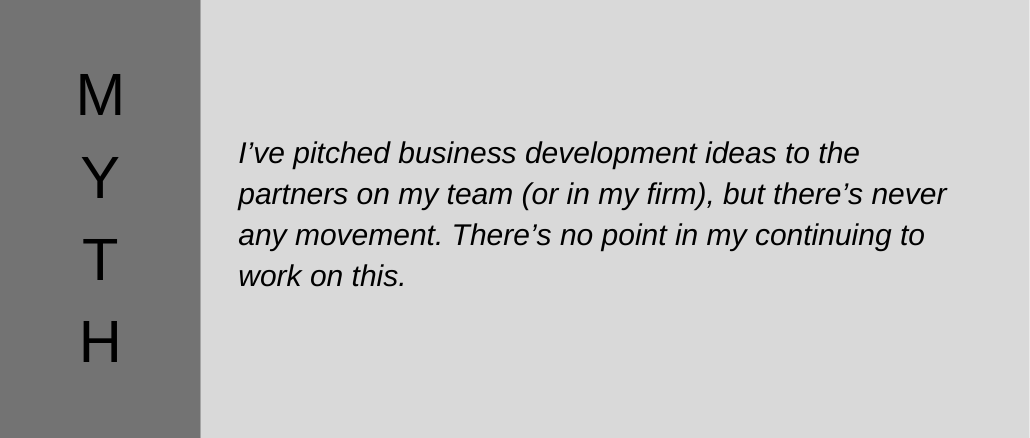Don’t Let Your Business Development Efforts Derail Your Firm’s Plans.
How does your business development activity fit with your firm’s plans?
The tagline for Fleming Strategic is Building the practice within the firm. Unless you’re a sole practitioner, you must recognize that while your business development objectives and activities are personal to you, they have to fit within the strategy, approach, and culture of your law firm, or you’re likely to hit roadblocks that will make your path bumpy or even impossible.
Today, I’m offering you an excerpt from my book Legal Rainmaking Myths: What You Think You Know About Business Development Could Kill Your Practice.
Paul was an ambitious Of Counsel practicing intellectual property litigation in a firm of about 100 lawyers. He was a second-career lawyer with a decade of experience in business and marketing, and Paul was teeming with ideas about how he might connect with new sources of business. He would periodically approach his team leader with ideas, and although the leader never explicitly rejected the ideas, he also never gave Paul the green light to move forward with them. Paul asked for a business development budget and was told none was available to him at his level of practice. He suggested that the firm sponsor an upcoming event and supported that request with data about the other sponsors and likely attendees, but he was told that the firm’s sponsorships were awarded based on partner requests only. Paul began to feel stymied, that he had no opportunity or flexibility to try new approaches to business development. He feared that his practice growth would suffer because of the firm’s reticence. The last time I spoke to Paul, he was gamely attempting to fit his approach to business development in the firm’s structure. When I looked him up a year later, he had left that firm.
Clients often tell me about various ways in which their firm, or some lawyers within the firm, stunted their business development efforts, either intentionally or through a lack of attention. If that’s your situation you may be facing the difficult decision of whether to stay or attempt a lateral move. However, there are steps you can take to address the situation.
First, get to the basis for the lack of progress. Is the block intentional, and if so, what’s the reason? You might consider whether the obstructive lawyers are uncomfortable with marketing in general (and if so, try to uncover the beliefs that are creating rainmaker numbness) or whether they’re simply not receptive to the ideas you’re pitching. If you find a general recalcitrance to business development activity, you will likely have an uphill battle to change that. You might raise the question of how the firm (or the team) sees its business development opportunities and determine whether the response is proactive or reactive. If the latter, you’re unlikely to create a shift on your own.
Second, if the stonewalling seems to be tied to your ideas in particular, consider whether your ideas are significantly different in character than the current activity. For example, have you suggested jumping into social media despite the fact that the firm has only a brochure-style website and no other virtual presence? Have you recommended a shift in the kind of client that firm might seek or a new strategy? If your ideas are out of step with the firm’s (or team’s) personality, you’ll probably find a great deal of resistance.
In either instance, you must evaluate the following questions:
- Can you be successful by adopting the firm’s approach to business development (or its decision to avoid that activity)?
- Can you suggest an experiment that would employ a low-risk, limited version of your idea to test it? (See Peter Sims’ book Little Bets for ideas on how to do this, and think critically about what parameters to use to ensure a fair test.)
- Can you implement your ideas without involving the firm or the team as a whole (for example, a newsletter for your clients rather than for all of the firm’s clients)?
- Are you willing to accept the limitations placed by the firm’s (or team’s) attitude toward business development or its strategy?
Your answers to these questions will determine your next steps.
If you’d like to uncover other rainmaking myths that may be blocking your way, perhaps we should chat. I have space for one new client this month. If you’d like to explore the opportunity, visit this link to schedule a free consultation.






Leave a Reply
Want to join the discussion?Feel free to contribute!